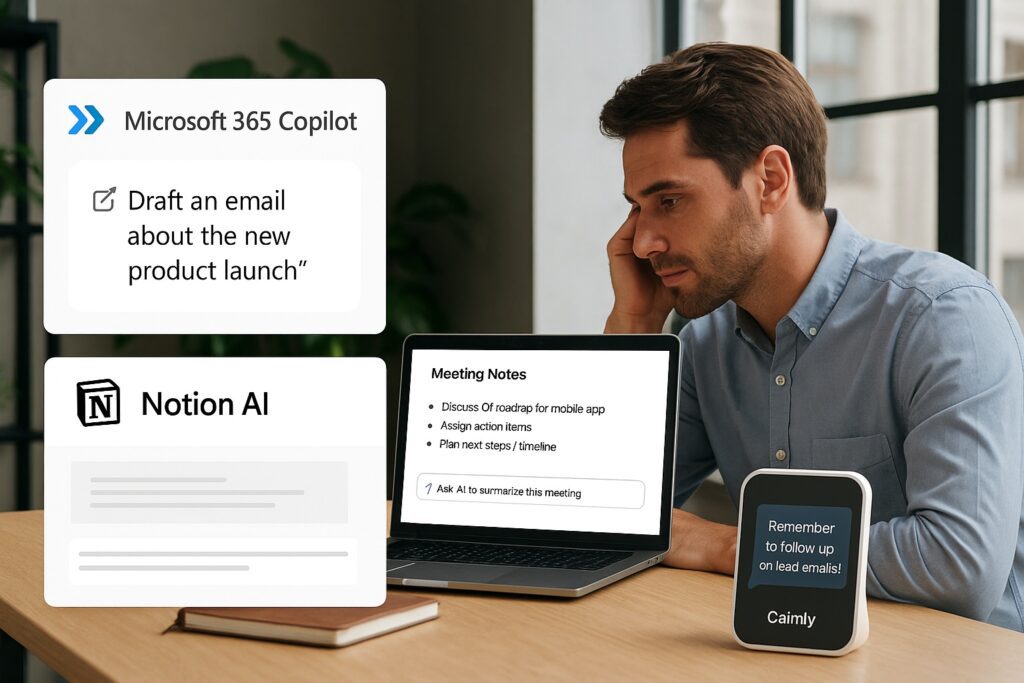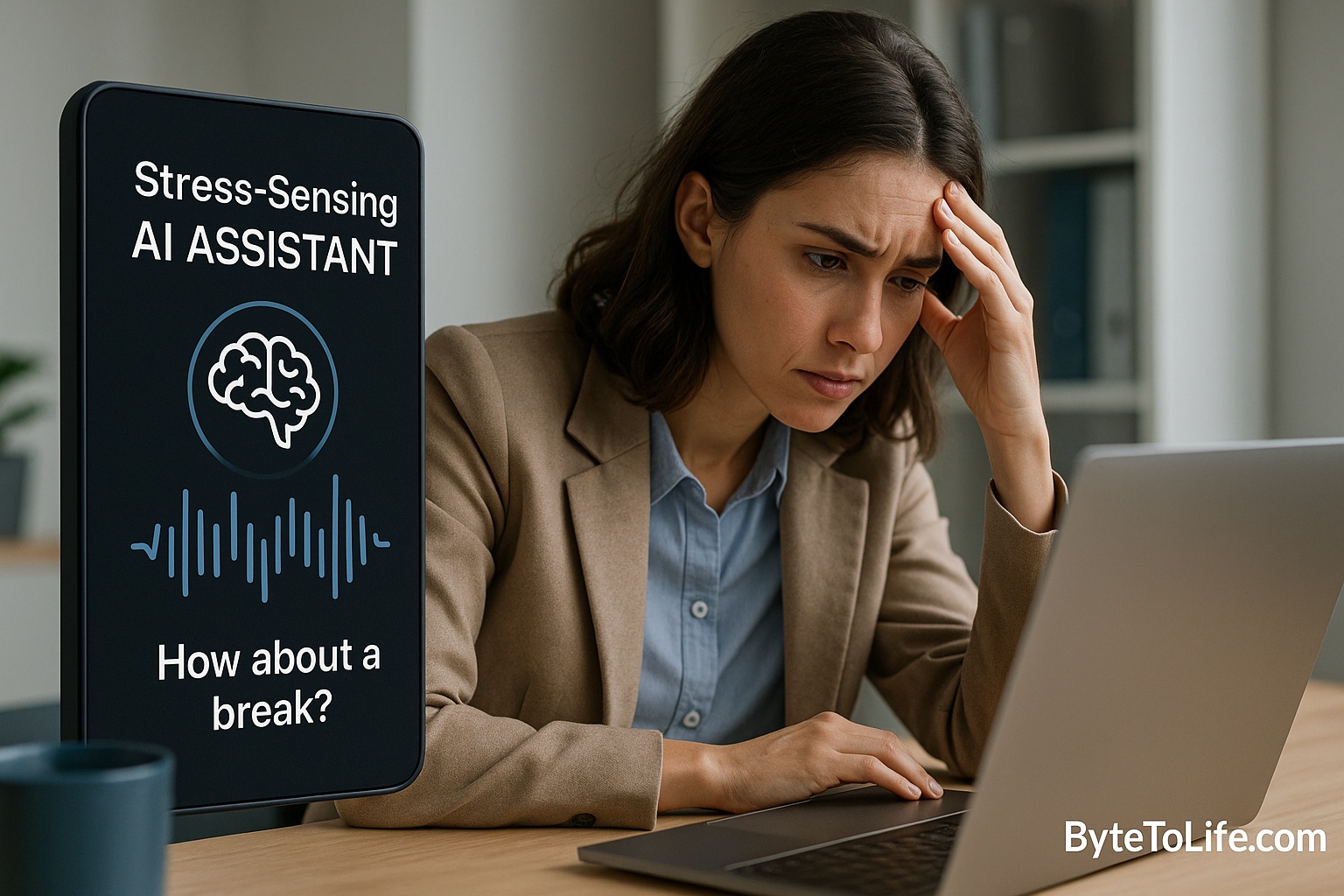In today’s high-pressure digital world, productivity isn’t just about working harder—it’s about working smarter, and sometimes, kinder. The rise of AI-powered productivity tools has helped streamline repetitive tasks like scheduling meetings or summarizing notes. But the next frontier is even more personal: AI assistants that sense and respond to your stress levels.
What Are Stress-Sensing AI Assistants?
Unlike conventional productivity bots that rely on text prompts or preset timers, these advanced assistants integrate with wearables, webcams, and microphones to analyze signs of stress. Think elevated heart rates, tense voices, facial expressions, or even eye strain.
Key Capabilities Include:
- Monitoring physiological signals (e.g., heart rate, temperature)
- Real-time emotion detection through facial and vocal analysis
- Providing adaptive workflows (pause notifications, offer summaries, etc.)
- Suggesting breaks or deep-focus sessions when stress spikes
One notable example is AdaptAI, a prototype that uses multimodal signals to adjust your workload dynamically based on your mental state. You can read the AdaptAI research paper here.
Why Gen Z Is Embracing AI for Boring Tasks
According to a recent report, 62% of Gen Z workers are interested in AI to handle repetitive digital tasks. Their goal? Freeing up time for creative or strategic thinking while letting bots take care of data sorting, calendar planning, or inbox zeroing.
What Makes These AI Tools Different?
Most productivity tools follow commands. But these AI assistants are designed to anticipate and respond proactively to human emotion. They’re not just task managers—they’re digital coworkers that help protect your mental wellness while improving output.
Compared to Traditional Tools:
- Time-blocking apps: Require manual input and rigid schedules
- Voice assistants: Follow one-way commands
- Stress-aware AI: Two-way interaction, proactive interruption, and smarter context
How They Work (Simplified)
Stress-sensing AI combines multiple layers of tech:
- Data Collection: Through webcams, microphones, or wearable sensors
- Signal Processing: AI interprets patterns like frowns, sighs, or restlessness
- Workflow Adjustment: Triggers a suggestion (break, summarize, reschedule)
Future Potential: Your AI-Powered Wellness Coach
Imagine this: You’re working remotely, stressed before a deadline, and your AI assistant dims your screen, plays soft music, and offers to summarize your unread emails. That’s the vision of AI productivity merging with emotional intelligence.
In the Near Future, Expect to See:
- Integration with smartwatches and AR glasses
- AI co-pilots that schedule based on mood, not just availability
- Custom well-being metrics inside productivity dashboards
Ethical Considerations and Challenges
With great intelligence comes great responsibility. Using AI to sense stress brings serious ethical and privacy questions:
- How much emotional data should a bot access?
- Could such tools be misused by employers?
- Is there a risk of algorithmic manipulation of mental states?
Transparency and consent will be crucial. Users must know what data is being collected, how it’s used, and have the option to opt-out at any time.
How to Start Using Stress-Aware Productivity Tools
While AdaptAI is still experimental, you can explore related tools that incorporate mental wellness and adaptive behavior:
- RescueTime – Helps you manage focus and gives burnout alerts
- PomoDone – Combines Pomodoro technique with task syncing
- Serene – Includes focus music and break suggestions
Pro Tips for Maximizing Productivity with Emotional Awareness
To prepare for the wave of AI-enhanced productivity, try the following:
- Pair task tools with mindfulness apps like Headspace or Insight Timer
- Schedule time for “mental cooldown” every 90 minutes
- Track your emotions each day to identify what’s causing your stress
Real-World Applications and Case Studies

Several tech giants and startups are already exploring AI tools that blend productivity with emotional intelligence. Let’s explore how some of them are using this emerging technology:
1. Microsoft Copilot
Microsoft has introduced Copilot into its Office suite, blending productivity assistance with AI-powered summarization, email drafting, and task prioritization. While it doesn’t yet read emotional states directly, its integration with Teams and Outlook shows a step toward adapting communication based on user context.
2. Notion AI
Notion AI helps users write, summarize, brainstorm, and even reformat notes. Some early adopters suggest its tone-adjustment feature can act as an emotional alignment tool—rewording content based on how the user wants to feel or sound.
3. Calmly
A new app designed to integrate ambient biometric feedback with to-do lists. It can change your task visibility and suggestions based on your heart rate and screen time. Calmly is still in beta but shows great promise for personal AI well-being support.
Deeper Ethical Implications
A rising issue is how companies are using these tools. If employers have access to emotional data, could it be used to monitor or penalize staff? Ethical implementation requires clear consent models, transparency, and anonymized data handling.
Regulatory bodies are beginning to explore the implications of emotionally-aware AI, especially in sensitive environments like healthcare, education, and remote workspaces. Expect more frameworks soon.
Practical Workflow Integrations
You don’t need advanced hardware to start benefiting from emotionally smart productivity techniques. Here’s how you can get started today:
- Use time-boxing apps with built-in break reminders like Forest
- Track your mood alongside tasks using tools like Daylio
- Sync Pomodoro sessions with music apps for dynamic energy matching
- Pair fitness bands like Fitbit or Garmin with notification filtering apps
How It Changes the Future of Work
As AI tools become better at understanding user sentiment, the workplace could evolve dramatically. Instead of rigid 9-to-5 expectations, systems may adjust task difficulty or suggest asynchronous collaboration based on team emotional metrics. This could lead to:
- Healthier remote work environments
- More sustainable productivity across time zones
- Reduction in burnout and presenteeism
Global Burnout Statistics and AI’s Role
According to a 2024 study by the World Health Organization, over 38% of remote workers report symptoms of burnout, including chronic fatigue, reduced performance, and emotional exhaustion. These numbers are even higher among tech workers and creatives. In the U.S., Gallup data indicates that two-thirds of full-time employees experience burnout on the job at least occasionally.
So how can stress-aware AI change this narrative?
- By offering timely prompts to take breaks, stretch, or refocus, AI assistants can reduce continuous strain.
- With emotional tracking, users can monitor their burnout risk over time and make informed lifestyle adjustments.
- Teams can establish healthier collaboration norms when they understand each other’s emotional bandwidth.
Imagined Interview: Early User of Stress-Sensing AI
We spoke with a beta user of Calmly, a wearable-integrated productivity AI.
ByteToLife: How has your workflow changed since using Calmly?
Lisa (Product Designer): “I didn’t realize how often I worked through stress until Calmly started alerting me. It’s like having a coworker who says, ‘Hey, you’ve been staring at that screen too long. Need a break?’ And I listen. I’m more focused now.”
ByteToLife: Would you recommend it to others?
Lisa: “Yes, especially for remote teams. It reminds us that productivity isn’t just deliverables—it’s mental clarity too.”
Industries That Could Benefit from Emotion-Aware Productivity Tools

While tech and knowledge work are clear early adopters, other sectors stand to gain significantly:
1. Education
AI tutors that detect student frustration or disengagement could pause lessons, change teaching strategies, or suggest interactive breaks. This could improve retention and reduce academic anxiety.
2. Healthcare
Medical staff work under intense pressure. AI that senses fatigue or stress can recommend shift rotations, or send alerts to supervisors when support is needed—potentially reducing errors.
3. Customer Service
Contact center agents often deal with high emotional loads. Emotion-aware systems could buffer workloads, offer real-time stress relief tools, or even reroute calls during high-stress moments.
Tech Roadmap: What’s Coming in the Next 3–5 Years?
Here’s what the future might hold for stress-sensing productivity AI:
- Emotional Wearables: More companies will release rings, earbuds, and glasses that measure subtle stress indicators.
- Smarter AI Models: Large language models will soon include emotional context to tailor suggestions more humanely.
- Standardized Privacy Frameworks: With rising use, international standards around biometric data privacy will emerge.
- Team-Level AI Moderators: Think digital scrum masters who track emotional dynamics and optimize collaboration accordingly.
Frequently Asked Questions (FAQ)
Can AI really detect emotions accurately?
To a certain extent, yes. Modern AI can detect emotional cues like voice tone, facial expressions, and even physiological data from wearables. However, it’s still evolving and works best when multiple signals (like facial + vocal) are used together.
Is my data safe with stress-sensing AI tools?
That depends on the tool. Always review the privacy policy and data handling practices of any platform. Look for tools that offer end-to-end encryption and let you control what data is stored or deleted.
Will this technology replace human decision-making?
No. These AI assistants are designed to support human productivity and well-being—not to replace your judgment. They act more like digital companions or nudgers rather than decision-makers.
Do I need special hardware to use emotional AI?
Not necessarily. Many tools use your webcam, microphone, or keyboard/mouse patterns to infer stress. However, using wearables like smartwatches or biometric rings can provide more accurate results.
How can I try these tools today?
Start with apps like RescueTime, PomoDone, or Daylio. These offer features like burnout alerts, emotion tracking, and workflow suggestions based on mood or focus levels.
Conclusion
Stress-sensing AI assistants represent a powerful shift—from treating productivity as pure output, to acknowledging the human experience behind the screen. These tools won’t just make us faster; they might just make us healthier.
Call to Action
If you’re ready to go beyond checklists and truly elevate your digital well-being, consider exploring tools that align with how you feel—not just what you do. Emotional intelligence isn’t just a human skill anymore—it’s becoming part of the software we use daily.
Follow more cutting-edge productivity trends and ethical tech innovations at ByteToLife.com.
Related Articles:



